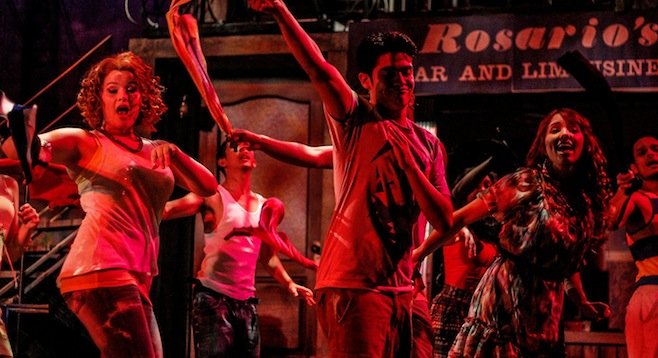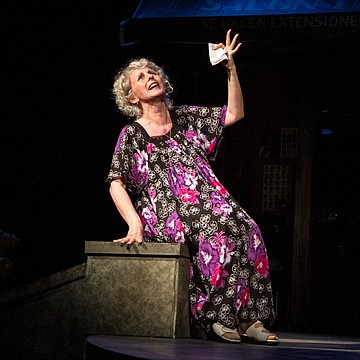 Facebook
Facebook
 X
X
 Instagram
Instagram
 TikTok
TikTok
 Youtube
Youtube

The Rep has opened its 38th season with a spectacular production of the Tony Award-winning musical. The evening seems to grow with every song. In fact, after a while when one tough act to follow leaves the stage, another one, equally tough to follow, moves into the spotlight.
Case in point. Someone living on the block at 183rd St., in Manhattan’s Washington Heights, just won the lottery. Usnavi’s financially-threatened bodega had the winning number. But no one knows who, so the community sings “96,000”: the victor’s amount.
Gentrification’s coming to the largely Latino area. Everyone’s affected: rents rising, shops closing. Changes loom, and the tensions even threaten fast friends and family ties.
As six or seven people state their case- each showing just cause for the $96,000 ticket - 20 dancers flash and leap and spill into the audience with such an amazing burst of energy (and precision) you’d think they all just won the grand prize.
Here and elsewhere Javier Velasco’s choreography is so dynamic that “96,000” threatens not only to stop the show, but to terminate it. How to follow such elation?

Bring out Susan Denaker. She plays Abuela (“grandmother”) Claudia, the block’s gray-haired matriarch. She turns her back to the audience, raises her head, and sing/shouts “calor!” – heat. And again. And again. And then skyrockets into “Paciencia y Fe,” a soliloquy/extended aria about her immigration from Cuba to New York in 1943, and how she’s needed patience and faith ever since. Bravos and howls and hands clapped raw refuse to let Denaker exit.
One of the tests of a musical: does the song you are hearing grab all your focus? Do you forget all the others?
Over and over this is what In the Heights does. Each number keeps your attention. One reason, they’re so personal. Lin-Manuel Miranda’s book and lyrics aren’t just character-driven, they’re individual-driven. There are no stereotypes. Usnavi, Abuela, Nina, Benny, and the others say and do unexpected things. They’re so carefully drawn that each has his or her musical genre.
Usnavi’s is rap (and multi-talented Jai Rodriguez’s Usnavi could carry the show by himself, if needed). Benny (Desmond Newson) and Nina (Chelsea Diggs-Smith) sing ballads. Danielle Mone Truitt (outstanding as Camae in the Rep’s The Mountaintop) does the hard-edged, nay-saying numbers. Others sing and dance salsa, or jazz inflections, or hip hop (even used in dialogue), and more traditional styles. The music’s as diverse as the people on the block.
And it’s so democratic that even the Piraga Guy (the excellent Victor Chan), who sells smoothies from a cart, for one instant may rule all of Manhattan.
The design work also has a democratic feel: Sean Fanning’s terrific set (the lights on the George Washington Bridge blinking behind graffiti-scratched storefronts); Trevor Norton’s lighting opts for dazzling, almost mythical reds and oranges; Valerie Henderson’s costumes are a color-wheel in themselves; and Tom Jones’ sound enriches every scene. All the elements blend, seamlessly.
For the last four years, the Rep has joined with the San Diego School of Creative and Performing arts and has staged a summer musical. This collaboration’s been so fruitful it’s hard to tell the students from the pros, be they on-stage or in the 13-person, brass-booming orchestra.
In the Heights has been criticized for keeping on the sunny side. And the frame tale’s more optimistic than expected. But listen to each song and the plights of the people. The harsh reality’s there (didn’t the pundits notice the brawl at the club?); the exuberant music functions as a time-out.
On opening night, director Sam Woodhouse announced that In the Heights begins the Rep’s 38th season. Woodhouse has a tall stack of quality shows to his credit. This one must rank near the top.


The Rep has opened its 38th season with a spectacular production of the Tony Award-winning musical. The evening seems to grow with every song. In fact, after a while when one tough act to follow leaves the stage, another one, equally tough to follow, moves into the spotlight.
Case in point. Someone living on the block at 183rd St., in Manhattan’s Washington Heights, just won the lottery. Usnavi’s financially-threatened bodega had the winning number. But no one knows who, so the community sings “96,000”: the victor’s amount.
Gentrification’s coming to the largely Latino area. Everyone’s affected: rents rising, shops closing. Changes loom, and the tensions even threaten fast friends and family ties.
As six or seven people state their case- each showing just cause for the $96,000 ticket - 20 dancers flash and leap and spill into the audience with such an amazing burst of energy (and precision) you’d think they all just won the grand prize.
Here and elsewhere Javier Velasco’s choreography is so dynamic that “96,000” threatens not only to stop the show, but to terminate it. How to follow such elation?

Bring out Susan Denaker. She plays Abuela (“grandmother”) Claudia, the block’s gray-haired matriarch. She turns her back to the audience, raises her head, and sing/shouts “calor!” – heat. And again. And again. And then skyrockets into “Paciencia y Fe,” a soliloquy/extended aria about her immigration from Cuba to New York in 1943, and how she’s needed patience and faith ever since. Bravos and howls and hands clapped raw refuse to let Denaker exit.
One of the tests of a musical: does the song you are hearing grab all your focus? Do you forget all the others?
Over and over this is what In the Heights does. Each number keeps your attention. One reason, they’re so personal. Lin-Manuel Miranda’s book and lyrics aren’t just character-driven, they’re individual-driven. There are no stereotypes. Usnavi, Abuela, Nina, Benny, and the others say and do unexpected things. They’re so carefully drawn that each has his or her musical genre.
Usnavi’s is rap (and multi-talented Jai Rodriguez’s Usnavi could carry the show by himself, if needed). Benny (Desmond Newson) and Nina (Chelsea Diggs-Smith) sing ballads. Danielle Mone Truitt (outstanding as Camae in the Rep’s The Mountaintop) does the hard-edged, nay-saying numbers. Others sing and dance salsa, or jazz inflections, or hip hop (even used in dialogue), and more traditional styles. The music’s as diverse as the people on the block.
And it’s so democratic that even the Piraga Guy (the excellent Victor Chan), who sells smoothies from a cart, for one instant may rule all of Manhattan.
The design work also has a democratic feel: Sean Fanning’s terrific set (the lights on the George Washington Bridge blinking behind graffiti-scratched storefronts); Trevor Norton’s lighting opts for dazzling, almost mythical reds and oranges; Valerie Henderson’s costumes are a color-wheel in themselves; and Tom Jones’ sound enriches every scene. All the elements blend, seamlessly.
For the last four years, the Rep has joined with the San Diego School of Creative and Performing arts and has staged a summer musical. This collaboration’s been so fruitful it’s hard to tell the students from the pros, be they on-stage or in the 13-person, brass-booming orchestra.
In the Heights has been criticized for keeping on the sunny side. And the frame tale’s more optimistic than expected. But listen to each song and the plights of the people. The harsh reality’s there (didn’t the pundits notice the brawl at the club?); the exuberant music functions as a time-out.
On opening night, director Sam Woodhouse announced that In the Heights begins the Rep’s 38th season. Woodhouse has a tall stack of quality shows to his credit. This one must rank near the top.
Comments